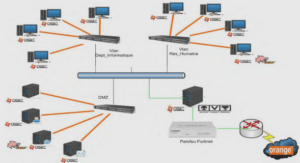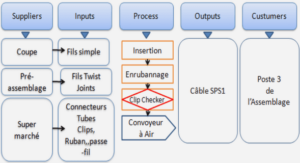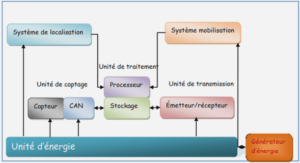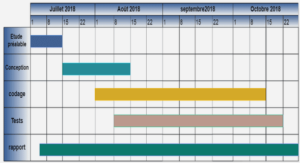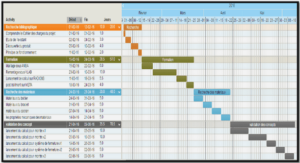Les agrumes dans le monde
Introduction
Natural biological control of pests in agroecosystems is currently receiving more and more attention due to the increasing emergence of chemical‐resistant pests, regulations governing the use of chemicals, and a strong social demand for sustainable agricultural products (Isaacs et al., 2009). An effective way to increase natural pest regulation consists in allowing spontaneous vegetation to grow and bloom in the field (in the crop itself, or as an inter‐row) or in the vicinity (field margin, non‐cultivated plant strips, ditches, etc.) (Landis et al., 2000; Olson and Wäckers, 2007; Bianchi and Wäckers, 2008; Isaacs et al., 2009). Indeed, most carnivorous predators and almost all parasitoids require plant‐provided food such as nectar (either in flowers or on extra‐ floral nectaries), pollen, honeydew, sap or cell liquids for optimal survival, fitness and fecundity (Wäckers, 2004; Wäckers et al., 2005; Hanley et al, 2007). However, the impact of weed management on plant‐provided food for predators and parasitoids remains poorly documented (Bàrberi et al., 2010). As a result, and given that nectar remains the main energetic food for flower‐visiting beneficial insects, there is a need for a tool to assess the nectar‐provisioning capacity of vegetation in cropping systems with the aim of optimizing habitat management. Classical bioindication methods rely on taxonomy and are often linked to specific environments, thus limiting their wider application. According to Feld et al. (2009) and de Bello et al. (2010), a functional approach is better as it can be used regardless of the environment and species under study. Functional floral traits are important features of plants that influence biological control by providing food to natural enemies as beneficial food complements or as substitutes in the case of prey/host scarcity (Wäckers, 2004; Wäckers et al., 2005). Hence, such functional floral traits can be used for inter‐habitat comparison of potential ecological service delivery (de Bello et al., 2010). As stated by Bàrberi et al. (2010) ‘as such, there is potential to conduct innovative interdisciplinary research on functional biodiversityrelated subjects and hence increase knowledge on the drivers of weed/arthropod interactions in agroecosystems across different spatial and temporal scales’. Like the pollination syndromes used to predict the attractiveness of flowers for pollinators (Faegri and Pijl, 1979), we propose the use of simple functional floral traits that are visible to the naked eye to predict the capacity of flowers to supply nectar to natural enemies of pests.
The aim of this paper is to propose an integrative indicator based on floral traits for assessing the nectar‐provisioning capacity of ground cover vegetation for beneficial nectarivores. We used the indicator in a tropical citrus orchard in the French West Indies with different weed management treatments. Weed control is one of the main constraints faced by producers in tropical humid environments. As weeds are hard to control in integrated production systems, this usually requires large quantities of herbicides (Le Bellec et al., 2011). How can weeds be managed in orchards with minimal herbicide use? Maintaining weeds as a free ground cover, i.e. as spontaneous vegetation, results in high orchard management constraints and high competition with the crop (such as water competition). However, maintaining weeds can also provide, in some cases, a free service for the enhancement of biological control (Cortesero et al., 2000, Grundy et al., 2010, Mailloux et al.,2010). What, therefore, is the best weeding strategy? This paper seeks to address this question with the creation of an indicator for predicted nectar provisioning capacity that can be used by non‐ scientists to make optimal weed management decisions.
Material and methods
The method consisted in i) characterizing the ground cover vegetation in a variety of situations, ii) assessing floral characteristics of each plant species identified and iii) aggregating the variables to build an integrative indicator. The method was tested in a field trial including six weed management treatments in a citrus orchard in Guadeloupe representing current and innovative weeding practices (Le Bellec et al., 2011). Chrysopidae family was chosen to assess the indirect nectar provisioning for the indicator validation.
Characterization of ground cover vegetation
We calculated three quantitative variables of ground cover vegetation: species richness (SR), ground cover rate (GC) and proportion of ground cover per plant species.Qualitative characterization of ground cover included two steps. First, the floral traits of each species were assessed and then a Floral Score (FS) based on interest of these traits was calculated. Three floral traits were considered: (i) flower morphology, (ii) corolla colour and (iii) corolla size. All these floral traits have been shown to influence nectar provision to biological control agents in previous studies (Hingston and Mc Quillan, 2000; Machado and Lopes, 2004; Wäckers et al., 2005; Chittka and Raine, 2006; Makrodimos et al., 2008; Winkler et al., 2009), and are easily observable with the naked eye. Other floral traits such as flower odour (Chittka and Raine, 2006) and nectar suitability (vitamin content, sugar ratio, amino acid, digestibility (Wäckers et al., 2005, Hanley et al., 2007)) were not selected due to the difficulty of observation.
A ‘Free access’ type flower species, characterized by largely open and capitate flower, was considered as it allows any flower visitor to feed on nectar regardless of its degree of specialization (Makrodimos et al., 2008), compared to flag‐shape flowers and small tubes which are more selective. Success in accessing nectar depends on body size, strength, intra‐guild facilitation (e.g. prior passing of a large visitor strong enough to force open the wings of flag‐shape flowers) (Hingston and Mc Quillan, 2000; Machado and Lopes, 2004). Nectar at the bottom of long tubes (more than 2 mm in length) is only accessible to specialist nectarivores equipped with elongated mouth parts (Machado and Lopes, 2004, Makrodimos et al., 2008) and therefore remains out of reach of nectar‐feeding predators.
|
Table des matières
INTRODUCTION
CHAPITRE 1. CONTEXTE, PROBLÉMATIQUE ET DÉMARCHE DE LA THÈSE
1.1 Les agrumes dans le monde
1.2 Les agrumes en Guadeloupe
1.3 Problématique et organisation de la thèse
CHAPITRE 2. UNE MÉTHODOLOGIE DE RECONCEPTION ET D’ÉVALUATION DES SYSTÈMES DE CULTURE DURABLES
2.1 Introduction
2.2 Material and Method: definition of the five steps in the DISCS method
2.2.1 Step 1: Diagnosis
2.2.2 Step 2: Objectives and prototypes
2.2.3 Step 3: Research loop at the experimental station
2.2.4 Step 4: Development loop on volunteer farms
2.2.5 Step 5: Territory loop
2.3 Results of a case study and discussion
2.3.1 Step 1‐Diagnosis: Comparing farmer’s practices to a reference crop management
2.3.2 Step 2‐Objectives, assessment and prototypes’design
2.3.3 Step 3‐Research Loop: test and multi‐criteri analysis of the experimental prototypes
2.3.4 Step 4‐Development loop: design of a decision‐aid tool for farmers’use
2.3.4.1 Spontaneous appropriation
2.3.4.2 Design of decision‐aid indicator
2.4 Discussion
2.4.1 Benefits of a participatory approach
2.4.2 Providing relevant multifunctional tools
2.5 Conclusion
CHAPITRE 3. CONSTRUCTION D’UNE TYPOLOGIE DES PRATIQUES CULTURALES BASÉE SUR LA COMPARAISON A UN ITINÉRAIRE TECHNIQUE DE RÉFÉRENCE
3.1 Introduction
3.2 Materiel and methods
3.2.1 Preliminary farm survey and farm typology
3.2.2 Stage 1. Analytical framework of crop management
3.2.3 Stage 2. Evaluation of crop management performances
3.2.3.1 An indicator for evaluating the state of tree health
3.2.3.2 A treatment frequency index for evaluating the level of pesticide use
3.2.3.3 Analysis of correlated crop practice performances
3.2.4 Stage 3. Collectively building the constraint framework
3.2.4.1 Statistically analysing the crop management constraints
3.2.4.2. Collective proposals for cropping system improvement
3.3 Results
3.3.1 Stage 1. Analytical framework of crop management
3.3.1.1 Defining and comparing observed CCPs with the RCM
3.3.1.2 Deviation from the reference crop management
3.3.2 Stage 2. Evaluation of cropping practice performances
3.3.2.1 Impacts of cropping practices on tree health
3.3.2.2 Impacts of cropping practices on pesticide use
3.3.3 Stage 3. Collectively building the constraint framework
3.3.3.1 A typology to analyse the cropping system constraints
3.3.3.2 Proposal for improvement of the cropping system
3.4 Discussion
CHAPITRE 4. COCONSTRUCTION DE PROTOTYPES EXPÉRIMENTAUX DE GESTION DE L’ENHERBEMENT POUR LES VERGERS D’AGRUMES EN GUADELOUPE
4.1. La gestion de l’enherbement en verger
4.1.1 Tactiques de gestion des adventices en verger
4.1.2 L’enherbement en verger, plantes de services
4.2 Choosing cover crops to enhance ecological services in orchards: a multiple criteria and systemic approach applied to tropical areas
4.2.1 Introduction
4.2.2 Material and method
4.2.2.1 Multicriteria grid construction
4.2.2.2 Multi criteria grid use
4.2.2.3 Guadeloupe experiment
4.2.2.4 Martinique experiment
4.2.3 Results and discussion
4.2.3.1 Step1
4.2.3.2 Step2
4.2.3.3 Step3
4.2.3.4 Selected cover crops
4.2.4 Perspectives: Prototyping and cropping system design
4.2.5 Conclusion
4.3 Coconstruction des prototypes de gestion de l’enherbement
4.4 Dispositif expérimental
4.4.1 Site d’étude
4.4.2 Implantation du verger expérimental
4.4.3 Implantation du dispositif expérimental
4.4.4 Management des pratiques culturales
4.4.5 Suivis et observations des prototypes
CHAPITRE 5. INTÉRÊT DES PROTOTYPES DE GESTION DE L’ENHERBEMENT EN VERGER D’AGRUMES DANS LE CADRE DE LA LUTTE BIOLOGIQUE PAR CONSERVATION
5.1 Predicting the nectar provisioning capacity of weeds to beneficial arthropods using an integrative indicator
5.1.1 Introduction
5.1.2 Material and methods
5.1.2.1Characterization of ground cover vegetation
5.1.2.2 Nectar Provisioning Indicator (NPI) construction
5.1.2.3 Sensitivity test of indicator
5.1.2.4 Field site and experimental treatments
5.1.2.5 Evaluation of nectar provisioning
5.1.2.6 Statistical analyses
5.1.3 Results
5.1.3.1 Influence of weed management treatments
5.1.3.2 Nectar Provisioning Indicator (NPI) scores
5.1.3.3 Evaluation of nectar provisioning
5.1.3.4 Sensitivity test results
5.1.4 Discussion
5.1.4.1 Impact of weed management on nectar provisioning
5.1.4.2 Validation of Nectar Provisioning Indicator
5.1.4.3 NPI: a decision aid tool for weed management
5.2 Influence of ground cover management on diversity and density of phytoseiid mites (Acari: Phytoseiidae) in Guadeloupean citrus orchards
5.2.1 Introduction
5.2.2 Material and method
5.2.2.1 Site and meteorological conditions
5.2.2.2 Treatments
5.2.2.3 Sampling, identification and data analysis
5.2.3 Results and discussion
5.2.3.1 Meteorological survey
5.2.3.2 Phytoseiid mite diversity
5.2.3.3 Phytoseiid mite density
5.2.3.4 Phytoseiid host plants
5.2.3.5 Potential of the phytoseiid species as control agents
5.2.4 Conclusion
CHAPITRE 6. ANALYSE MULTICRITÈRE DES PROTOTYPES DE GESTION DE L’ENHERBEMENT
6.1 Multicriteria assessement of weed management in tropical orchard by means of indicators
6.1.1 Introduction
6.1.2 Materiel and methods
6.1.2.1 Transformation of the improvement objectives into appropriate
6.1.2.2 Selection, adaptation or design of indicators
6.1.2.3 Aggregation of the indicators
6.1.2.4 Case study: new weed management practices in citrus orchards
6.1.3 Results
6.1.3.1 Prototype performance indicators
6.1.3.2 Environmental risk indicators of each prototype
6.1.3.3 Final assessement
6.1.3.4 Sensitivity test results
6.1.4 Discussion
6.2 Rappel et illustration des principales performances des cinq prototypes de gestion de l’enherbement au terme des trois ans
DISCUSSION GÉNÉRALE
1. Surpasser les conflits d’intérêts par un dialogue entre acteurs à chaque étape de la re conception
2. Trois familles d’acteurs, trois référentiels
3. Faciliter les échanges d’information en adoptant une démarche d’amélioration continue
4. Matérialiser les supports d’échange entre acteurs par trois objets de transfert, produits des boucles de progrès
5. Répartir les rôles des acteurs entre deux niveaux d’intervention
6. Favoriser des innovations appropriables
7. Permettre à chaque acteur d’évaluer ses résultats par rapport à la problématique commune
CONCLUSION
RÉFÉRENCES CITÉES
ANNEXES
RÉSUMÉ
SUMMARY
![]() Télécharger le rapport complet
Télécharger le rapport complet

